Montessori Pathways' News
October, 2012
Notes from Miss Alena
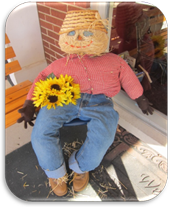
October began with the delivery of the school library books, which had been ordered with the Mums Sale Fundraiser money. Both of our Primary Classrooms (ages 3-6) received several sets of Primary Phonics Books, to help develop reading skills.
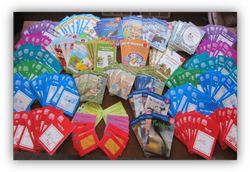
The Elementary class received the highest level of the Primary Phonics books, as well as several sets of fiction books for group reading and many non-fiction books.
I wanted to share my observation of the Elementary classroom. The children have a non-fiction reading area, as well as a fiction reading area. However, the non-fiction area appears far more popular among the kids! The students spend a lot of time there, and if any debate or disagreement arises, they head straight for this area to learn more information and reach a conclusion.

In the middle of October we held our first Parent Evening, “Developing Problem Solvers through Critical Thinking Activities.” Thank you to everyone who attended! One of our parents later said that “the meeting was very inspirational.”
Our next meeting will be Wednesday, November 7th, at 6:30: “This is My Classroom.” We invite all of the parents and their children. During this evening, the children will have a chance to share their favorite area and materials at the moment. We hope to see you there!
I would like to close with an anecdote from the Elementary class. While driving some of the Elementary students to a field trip, I listened to their conversations with each other. Compared to last year, their conversations are much more mature and informed. They have started utilizing evidence, drawing conclusion and analyzing.
For example, one of the kids was sharing the story of how her tooth had fallen out. While eagerly waiting for the tooth fairy at night, she kept peeking every time that the door opened, but it was only her mom. Then, when she had woken up the next morning and discovered a surprise under her pillow, she decided that it was her mom and not the tooth fairy who had left it because “I fell asleep when my door was open but I woke up to find it closed. The tooth fairy is so small and fragile; she couldn’t have closed the door on her own! It must have been my mom.”

Another time, on the way back from the farm, the children were very excited. One of the boys was very excited a bit louder in the car, so a girl was asking him to stop, to calm down, to lower his voice, etc. And then, she began spelling it: “S-T-O-P. S-T-O-P I-T.” The boy responded likewise: “N-O. Two syllables.” The girl corrected him, stating that the word is two letters, but one syllable, which lead the children to an experiment of syllable clapping, as they had done in Kindergarten with Ms. Jocelyn. A discussion of respecting each other’s feelings continued, which lead the boy to state that he will just tie his shoes instead. The girl responded with “yes, tie it and please, be quiet.” They were excited to discover the spontaneous creation of a rhyme, which lead to a whole different discussion of rhymes!
We had a wonderful morning on Halloween! Everyone’s costumes were so cute, kind, and creative. A popular costume of a drying machine was actually hand-made by one of the moms!
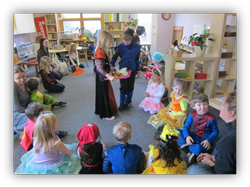
The preschoolers visited each other’s classrooms, sang songs to each other, and finished by singing a song together. It was amazing to see how friendly and organized the children were throughout the morning. The preschoolers also visited the Elementary classroom to show their costumes. They heard a performance by the Elementary kids and received special treats from them. It is wonderful to see the Elementary children taking care of their younger friends.
The teachers and I are so happy to have an Elementary class this year as it not only gives the children a chance to continue their education, but also provides the entire school with leaders. There is a strong sense of care for the younger children in the school and it makes for a wonderful atmosphere throughout the day.
Thank you very much to all our teachers, who prepared and organized this wonderful celebration, and Ms. Mary Perrone, Mr. Bob Pan, Ms. Rochelle Smyk, Ms. Linda Mugdur for their help during this event.
Warmly,
Miss Alena
Working with Montessori materials:
The Silence Area in the classroom
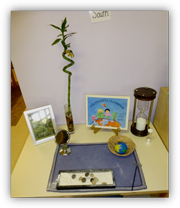
Some call it the peace area, the silence corner, the peace table or the peace shelf. All these names and places in the Montessori classroom serve a similar purpose. It is an area where the children are able to go and calm their minds and bodies. This area in the classroom is for one child to visit at a time when they feel the need. While in this area, it is the expectation that the child is quiet and the other children are expected to not disturb the person visiting the peace area.
The peace area in the elementary classroom is located at a table. On the table we have a book titled “Our Peaceful Classroom” which is written by children from Montessori schools around the world. Other items at the table include a stress ball, a large and small sand timer, a plant and a nature picture. The children also came up with a list of guidelines to follow while visiting the peace table.
On this table we also have our peace stone placed in a basket. The stone is used when there is a conflict between two students. One brings over the peace stone to the student whom they are having a conflict with. While holding it, they state what happened and why they are upset to the other student. The stone is then passed. The child who was listening repeats back what the first child said. This is a skill that takes some work because it requires active listening during a conflict (something that is difficult for adults at times too). The child who repeated the problem to the fist student then gets a turn to either apologize or explain their point of view and it continues until the conflict is resolved. This takes practice, but the children appreciate the process and utilize it when a conflict arises.
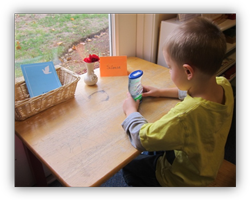
In the South room there is also a peace table that has a basket with a little sign that says "Silence", a Book of Peace (peace symbols and words from around the world) and a liquid timer (which is quite mesmerizing). The Peace Table faces the outdoors. There is also a special basket used for practicing group silence that has a variety of quiet instruments (earth bell, chime eggs, rain forest frog croaking) to play to signal end of silence.
Group silence is an activity practiced in both the early childhood classes and the elementary classroom usually once per day. It is a time of quiet reflection and a chance to build self-control. During the next few weeks the South room will be adding a peace rose for conflict resolution and a quiet rug. The peace rose is used in a similar way as the peace stone in elementary. One child speaks by telling what they want and why ("please don't shout, it hurts my ears") then passes the rose. The other child apologizes and passes the rose back then the first child says "thank you". The peace rose will help to establish whose turn it is to talk and be able to engage both children to listen and speak in the process.

The East room has a similar process used for conflict resolution. They also utilize a quiet area, which contains books for the students to quietly read and look through, and a relaxing tabletop fountain.
Peace education is an extremely important part of the Montessori education. We strive to give the children tools and opportunities to experience peace and learn about peaceful living in many ways. Consider making a peace area in your home for all the family to use. I am sure we could all benefit from some quiet time every now and then!
Miss Katy
Working with Montessori materials:
The Mystery Bag
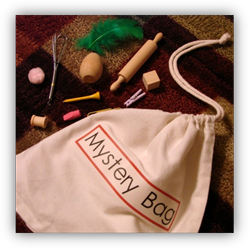
The Mystery Bag's purpose is to refine the stereognostic sense and material visualization. Also, this work presupposes that the child already knows the names of each of the objects used.
The materials for this work include an attractive bag with approximately 10 objects that are very different from each other, such as a key, a cotton ball, a pine cone, a button, a small basket, etc.
The procedure for this work begins by inviting the child or children to come and work with the teacher.
The teacher places the bag flat on the table with the opening near her, puts one of her hands into the bag, chooses one object to feel, and tells the child/children what she feels (i.e. soft, fluffy, light, etc.) The teacher than states a guess: “I think this is a cotton ball.” Then the teacher allows the child to try. She reminds the child to feel, and then to say the object’s name before taking it out of the bag.
When all of the objects are out of the bag, the teacher can ask the child to pass a specific item to her to put back in the bag. This gives the teacher a chance to note if the child knows all of the names of the objects (vocabulary skills).
The next step requires the teacher to describe the object and asks the child to find it in the bag (no peeking) and take it out. Or ask the child to grab any object and name it before taking it out. “Why do you think that this is a cotton ball?” When most of the items are taken out, the teacher can ask:
”What objects do you think are left in the bag?” (Memorization skills).
The Mystery Bag is a great activity for "At Home Montessori" because of its ease of use and its infinite possibilities to increase your child's language and sensorial skills. Enjoy!
Miss Ellen
Colored Cylinder Blocks
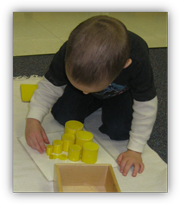
In the Sensorial area of a 3-6 Montessori classroom, one of the first works a child will be naturally drawn to is the Colored Cylinder Blocks. There are four different colored 10 cylinders sets in this work. A child may work with each color separately or combine them together.
The yellow cylinders vary in height and width. The shortest cylinder is the thinnest and the tallest cylinder is the thickest. The red cylinders are the same height, but vary in width. The blue cylinders have the same width, but vary in height. The green cylinders vary in height and width. The shortest cylinder is the thickest and the tallest cylinder is the thinnest.
Montessori sensorial works engage a child to explore hands-on materials through their senses. For the Colored Cylinder Blocks the variation in visual look (color, height and width) and tactile sense (weight) focuses a child’s attention to notice these details while manipulating and independently discovering how to visually discriminate and organize materials.

Children independently discover many ways to manipulate these materials, including matching them with the knobbed cylinder blocks, stacking them on top of each other to form a tower or arranging them in size or different patterns. After much exploration they are excited to discover that when the yellow, red, and green cylinders are placed on top of each other, they all are the same height.
Why is it important for a child to learn through discovery? A child experiences a joy for learning when engaged in independent discovery. Studies show that children and adults both learn best during a hands-on discovery process (as opposed to rote memorization ). Montessori offers a structured environment with prepared materials that offers a child the opportunity to try, make mistakes and then learn from those mistakes.
For example, if a child tries to build a tower using the red colored cylinders and uses the narrowest cylinder as the base, she will soon discover that the tower will fall and the widest cylinder should be the base instead. This foundational knowledge will assist that same child later in other problem solving situations where balance, symmetry or proportion is required.
Miss Jocelyn
Notes from the Elementary Class (North room):
Ms. Katy

“Ms. Katy, I want to make a book of maps.” “Can we make a list of all the presidents?” These are two examples from the month of the wonderful way a Montessori classroom can work. While the children were in the midst of completing work from their work plans this month, the children came up with some of their own ideas. When a child asked about making a book of maps, we decided to make a plan. He came up with the idea of starting with the world map and once a week he can make a new map. Upon other children seeing him create his world map, which involved tracing, coloring, cutting, labeling, hole punching and sewing, they decided they wanted to make one. After getting to a good break point in their work plans, these children were able to make world maps too. Besides labeling the continents, some decided to draw the equator, a compass and label the five oceans.
Another child decided to make a map of Illinois based on an atlas he brought to school. All on his own, he added cities, The Fox River and labeled the bordering states. I am so grateful that our children are in an environment where this spontaneous, academically focused and creative work can be done!

As for the list of presidents, two children decided to first put our president cards in order after talking about the upcoming election. Upon doing this, I asked what would you like to do with these?
They came up with the idea of making a list of all the presidents. I gave each a roll of receipt tape and they proceeded to write each name. When finished, these lists stretched across the entire room. We left them out, unrolled, for the morning for all the class to see!

We also had the opportunity to visit Goebert’s Pumpkin Farm this month. The farm has a wild animal exhibit on display. Before going we talked about where wild animals usually belong and how we felt about them being at a farm in Illinois. The children seemed to agree that these animals should be free in the wild, but we also agreed it would be pretty neat to see them up close. While on the field trip the children kept count of how many animals they saw from each continent of the world. The following week, they counted up their data and were shown a bar graph work to use to represent their data.

The following week we made another bar graph to represent all of the birth months at Montessori Pathways.
We continue to move along in math and language. The children are compiling animal research to display at the parent/child night on November 7th. Some children are working on four-digit static and dynamic subtraction at this time and others have begun work with multiplication.

This month we also participated in an activity called Pinwheels for Peace. While at my Montessori institute at the beginning of the month, a teacher passed onto me a pinwheel made by her class and a template for us to make our own. We were to take a picture of our class with the pinwheel from her school and send it back. Then we were asked to send more pinwheels onto other schools. Each student in the elementary class colored a pinwheel and chose a state to send it to. We found Montessori schools in each state chosen and mailed them off. The states we sent Peace Pinwheels to were Michigan, Indiana, Hawaii, South Carolina, Arizona, California and Texas.

We concluded our month with our first Great Lesson of the year. The elementary Montessori curriculum contains five lessons known as The Great Lessons. The first is the story of our universe. As the story is read, different dramatic demonstrations are given which include a balloon filled with confetti to illustrate the Big Bang and a Volcano eruption towards the end of the story to show how hot the earth was and how it was filled with volcanic activity. The children had a great time. Some comments afterwards included, “I liked when the balloon popped and the volcano! Scientists thought there was a big bang and it just popped!”
Thank you to Nicole Wagler for volunteering to help with our spooky science experiment morning. It was so much fun to invite the other classrooms in to join us. In November we will be preparing for the parent/child night on the seventh. We will also be doing our second Great Lesson: The Coming of Life. Our last big event in November will be our Thanksgiving Celebration!
I would like to encourage parents of any class to come in for a visit to the elementary classroom if you have the opportunity. We would love to have you come in and observe!


Miss Katy
Spooky Science Fun!

On Tuesday, October 30th, the elementary class hosted the East and South room for some spooky science fun! It was a good time for all. The elementary class prepared for the experiments on Monday. Each was demonstrated and then they picked which experiment they wanted to exhibit for the preschool and Kindergarten children. Once chosen, the elementary class got together with their partner and tested the experiments. They were very excited. One student went as far as to say, “This day rocks!”
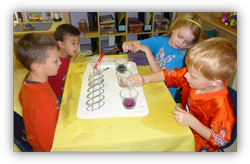
The elementary children came in Tuesday morning and were well prepared to begin the experiments with the other classrooms. The four experiments were titled Frankenworms (making gummy worms appear alive using baking soda and vinegar), Goblin Goo (slime made using cornstarch, water and food coloring), Fizzy Balloon (inflating a balloon on a bottle using baking soda and vinegar), and Magic Potion (cabbage juice mixed with baking soda and vinegar).
I wish we had videotaped the fun that ensued. The surprised faces of the kindergarten and preschoolers as the purple fizzy liquid overflowed when the potion was mixed and the look of excitement as a balloon magically inflated was priceless.

As for the elementary students, this was a time where their personalities shined! They were such gracious hosts and were thrilled to share their knowledge with the younger children. Some added their own jokes to the experiments and created somewhat of an educational comedy routine. Others not only demonstrated the experiments, but also carried on nice conversations with our guests asking about Halloween and what they are going to dress up as.

Overall, it was a wonderful morning. I want to thank Mrs. Wagler, Aaron’s mom, for bravely coming in to help with the experiments. I also want to thank Lincoln’s grandmother, Treyson’s mom and Qunicy’s mom who were in helping in the East room, but also stopped in to visit.
I know that the elementary children are excited about doing this again next year. They even started thinking about how the experiments worked and what didn’t and what we should change. Perhaps with their creative minds they can come up with some of their own experiments! We look forward to hosting the South and East rooms again!
Miss Katy
Notes from the South Classroom
Ms. Jocelyn and Ms. Ambreen

With the fall season in full swing, the South Room the children are working on a wide variety of activities that reflect our changing natural world in both our indoor and outdoor environments. Our month began with a fun special morning outdoors where the children rotated in small groups to help with raking leaves in the play yard, planting a paper white bulb to take home and creating a one-of-a-kind leaf rubbing. To finish off our morning, we all enjoyed a healthy group snack in the gazebo with our generous parent helpers, Ms. Sally (Shawn and Alia’s Mom) and Ms. Tammy (Sydney’s Mom). Thank you for helping making this a fun and meaningful fall morning outdoors.
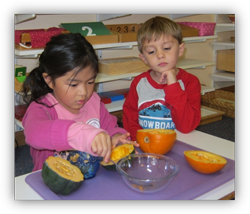
In the Science area, new fall works include life cycle of the pumpkin, parts of the pumpkin, pumpkin matching cards and giant pumpkin tracing. The children in the South Room also helped complete a project the Kindergarten group started; scooping out seeds and fibrous strands from a variety of squash (acorn, spaghetti, butternut and pumpkin). The seeds were then washed and toasted and tried in a tasting activity with the Kindergarten and Pre-kindergarten afternoon group. It was a true community project!

Also in October we were so excited to receive a beautiful new math bead cabinet in the South Room (Thank you, Alena!) The older children will work extensively with the bead cabinet materials this year to develop their skip counting skills and foundational work for understanding multiplication.
Many children in the South Room are already very interested and engaged in daily language works. In addition to working on their letter sounds, sight words and reading, a new work called October Words incorporates oral language, word decoding and categorizing skills. The October words include factual information about the month, holiday-related words and environmental vocabulary. This work encourages critical thinking and manipulating prior knowledge to apply it to problem solving strategies.

In Practical Life, the children had many fun art projects to try in October: pin-poked jack-o-lanterns, 8-legged accordion spiders, blot painted pumpkins and Halloween bead bracelets.

This month we also had a special Harvest Art Project Morning in the South Room. The children had the opportunity to visit 4 different art stations to try different art techniques, materials and skills in order to finish 4 harvest art projects (harvest veggie prints, paper bag scarecrows, tissue Indian corn and pumpkin sculptures). Thank you to Ms. Sally (Shawn and Alia’s Mom), Ms. Tammy (Sydney’s Mom), Mr. Michael (Logan’s Dad), Ms. Kelly (Zoey’s Mom) and Ms. Nicole (Jake’s Mom) we couldn’t have done it without your help!
New fine motor activities include keys and locks, nuts and bolts, build a flashlight and Halloween object transfer with chopsticks.

Also, thank you to Malcolm and his Mom for our new large indoor plant for our plant care work. This month our tasting activity was 3 different pear varieties. The children had the opportunity to participate in small groups to use all their senses to explore Bartlett, Bosc and Red Pears. The pears were a huge hit, with the clear favorite kind being the Red Pear. Thank you to all our families this month who contributed fruits, veggies and flowers for our classroom sharing basket.
During our line and group time this month, the children have been learning some fun fall and Halloween songs and dances. Perhaps you’ve been hearing them at home? (Spooky, Spooky Halloween or Halloween Time is coming) They are excited to perform them during our Halloween morning festivities for the children in the other classes.
Also during line time this month, our featured author was Audrey Wood. Thank you to James and his Mom for going to the library and selecting a wonderful stack of Audrey Wood books for us to read together as a class.
Finally, thank you to all the parents who attended fall conferences this month. It was wonderful to meet with you, hear your thoughts and share our observations for the year so far. Please remember, we are always available to meet or talk, so please do not hesitate to contact us as questions arise throughout the year.


Warmly,
Miss Jocelyn and Miss Ambreen
Kindergarten Extended Day News
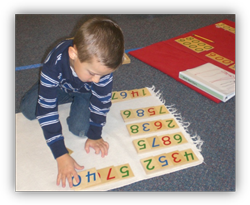
The Kindergartners have been very busy this month! In addition to their daily work in Math, Language, Writing, Sciences and Practical Life, the Kindergartners were introduced to some new concepts. The Kindergartners are expanding their basic knowledge of numbers by completing a work called “Number Building”. Using foundational skills they have acquired as preschoolers, they now use the Montessori numeral cards to create 4-digit numbers. This work requires a lot of organization and practice stacking and reading the numbers correctly and is practiced and repeated to ensure mastery prior to adding 4-digit numbers.

Clock work was introduced this month. The children are learning the correct vocabulary and working with the hands-on Montessori clock to manipulate and record the correct analog time. The ch ildren first learn hours, half hours, quarter hours then five minute intervals.
Money work was also introduced this month. The children are learning the coin names and values as a foundation to the Kindergartner’s upcoming responsibility of counting and tallying the coins collected by the school community from Trick-or-Treat for UNICEF.
As October began, the Kindergarten group read several non-fiction books together about Christopher Columbus, created maps to show the path his three ships sailed, practiced writing Columbus Day words and created October Word Books. As an extension to showing comprehension and recollection of new knowledge, the Kindergartner’s completed journal writing activities about Columbus.

In Science, the Kindergartner’s studied all about pumpkins and squash varieties. In addition to learning the scientific names for the parts of a squash, they studied and read about the life cycle, sketched and painted a pumpkin, tried pumpkin seed estimation, weighed and measured a butternut squash and tasted toasted squash seeds.

As a real-world extension, the class visited Cody’s Farm in Marengo to participate in their Pumpkins: From Seed to Table program, tour their family farm and ride out to cut a pumpkin off a vine to take home. As a fun final Kindergarten project, each child selected and brought in a squash to make a “Funny Face Squash”. Using a variety of art materials and their imagination each child transformed their squash to have a funny face. Here are some of the ideas they came up with: animal faces, yarn hair, paper hands, wiggly eyes, pom pom noses, pipe cleaner ears and felt hats.
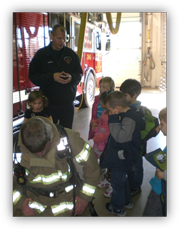
October is Fire Safety month. In preparation for a field trip to the fire station the Kindergartners learned about fire safety and emergencies that require calling 9-1-1. In class, a hands-on activity gave the children the opportunity to “practice” dialing 9-1-1 using a real cordless and cell phone (not charged, of course). We also read several books about fire safety and completed a group activity deciding which circumstances require calling 9-1-1.
On our walking field trip to the Crystal Lake Fire Department the children were given a tour by Firefighters Matt and Scott. They received a special behind-the-scenes tour of the office, living, and equipment areas, watched a fire safety video (while sitting in the firefighter’s giant leather rocking lazy boy chairs!) climbed in an ambulance, and talked to a firefighter who was wearing full fire gear. Firefighter Matt provided the children with a lot of important safety information and was very surprised to see how much they had already learned and was easily able to answer many of his questions!
In Art and Drama this month, the Kindergarten children tried some new activities. With Ms. Terri, the Kindergartners explored the work of Wyeth and the idea of a landscape. With guidance, each child implemented art techniques to look for details outside to accurately create their own landscape work of art. The final landscape works will be on display soon.
As a foundation for drama performances later this year, the Kindergartners took part in acting out a “Participation Story” called Why the Cedar is Ever Green. After the initial read-thru of the story, we practiced acting out a variety of action words from the story such as hobbled, snuggled, dragging and flapping a wind, dancing and swaying or shaking your branches. Once everyone practiced all the actions, the children were then able to choose a specific character to act out in the story. The children organized themselves to face me (the audience) and as I read the story they acted out their part as I said the words. The children absolutely loved this activity and we will continue act out participation stories throughout the year. As an interesting side note, after our first participation story, I have observed a lot of spontaneous “play acting” with the Kindergarten group outdoors on the play ground (great for social skills and cooperative play!)
Miss Jocelyn
Notes from the East classroom
Ms. Christine and Ms. Ellen

October has blown in and flew out with many opportunities for fun, fall projects and excitement about this transitional time of year. Hopefully, you have had an opportunity to meet Mr. Scarecrow at the front door; he did not magically appear - much discussion of how to create him occurred prior to making him (and thanks to Jennifer Dearlove for braving that cold, windy am!). We learned why farmers put scarecrow in their fields, the migration of birds in the fall and most importantly, what does one stuff a scarecrow with? Here are a few ideas: bath tissue, candy, paper, rubber chips from the playground, blankets, and, yes, finally.......straw!

We had a fun time, although the morning was chilly; we persevered and even had cornbread and apple juice in the gazebo afterward. Votes were cast and the front door location won so we hope you all are enjoying the show while it's "in town". By the way, the basket hat was a last resort; the baseball cap was not a good option (Cubs/Sox issue).
Inside our classroom, it is equally busy and challenging. Now, when the weather is cold, the coats and hats and gloves are a lesson in zipping and hanging on hangers. We have a great resource of helpers who are so patient at showing younger classmates how to manage this, and encourage parents to patiently and routinely practice these skills at home. Every child shows such pride and accomplishment in saying "I did it!" , and it truly just takes a few extra minutes of practice for them.

In the Art section of the classroom, ghosts, spiders and pumpkins are being replicated, and we are encouraging your children to not only be an "illustrator" of their work, but to also be the "author" by giving/creating in-depth details. Some of the children have put together two stencils to create a cat-bat (rhyming words, also), witch-o-lantern, etc. Please check their Montessori bags nightly and ask them to further share details of their incredible imaginations!
Practical life has introduced a wonderful new experience of grating cinnamon sticks to a fine powder which is then transferred to a supply for an upcoming Thanksgiving cooking project.
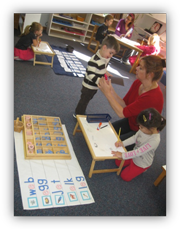
Your children are exploring Language in the classroom on a daily basis; introductions to letter sounds, beginning sounds, word building as well as reading to Ms. Ellen or Ms. Christine is happening every single day and much progress and success is already apparent. Look for books for practicing in children’s bags as well as opportunities to challenge their skills while you are together as a family.
Repetition in Math is also an important tool to acquiring mastery of math facts and functions. You may see your child is associating quantities with numbers, last month using apples and this month, it's pumpkins as counters. This repetition is important work and solidifies a child's understanding of this skill. For some beginners, we are working on tracing/tracking writing number formation. Other classmates may be working on the Hundred Board or Odd / Even numeral recognition.

Creepy critters have slithered their way into the Science area; parts of a Spider and Bat are available along with our classroom library as an additional resource for further reference and photographs.
Thank you for all of your Sharing Basket items and to our parent volunteers who help with special projects and tasks on a regular basis.
If you are able to share some time with our class, please let us know. We always appreciate extra help and your children love to have you be a part of their day.
We are looking forward to celebrating the holidays together!
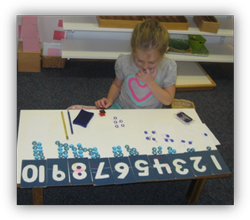
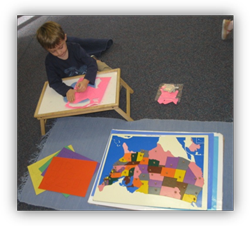
Sincerely,
Ms. Christine and Ms. Ellen
Notes from the afternoon classroom
Ms. Terri
Greetings from Ms. Terri!

Leaves may be fun to pile up and jump in and apples may be fun to pick from a tree and eat, however, the afternoon class has also used them in our art projects.
The pre-kindergarteners did an art project choosing from 9 different kinds of apples. Each variety has a different shape, color, taste and size. We looked at the colors and variations of circles and ovals. Each child picked 3 apples which they drew and colored with craypas. The purpose was to blend colors to achieve the dark purple red of the Red Delicious apple or the pale green and yellow and red of the MacIntosh apple. We finished with watercolor paints for the background.

We collected and traced assorted leaves for our next project. The children chose their own leaves to make a collage on water color paper. We drew then outlined each leaf looking at the size, shape, colors, veins, stems, etc. (Great extension for the parts of the leaf work in the classroom.) We painted each leaf one at a time with water first, then placed small amounts of water color on the wet surface to see the colors blend and flow. This is called wet-on-wet technique. It was an extra special time because we were able to paint our leaves outside on the tables under the gazebo. How fun is that!

For our kindergarten work this month we looked at a couple of Andrew Wyeth books concentrating on his pictures of landscapes. The children practiced drawing techniques looking at the light to dark values in his sketches. This included controlling the pencil – pressing lightly or heavily to achieve the desired value. We learned how to cross-hatch to make our value deeper. Next, we took our papers or clip boards, pencils and erasers outside to draw from nature. Our “landscape” consisted of plants and leaves in front of the fence in the back of the playground area.
It was great! As the children were drawing, I would hear comments like, “this stem is really tall”, or “the darkest part is on the ground”, or “the branch on this plant bends around”. With a little guidance, demonstration and examples to look at, the children were able to really see what they were attempting to draw. Weather permitting, we plan to return to our nature spot and continue to add to our drawings.

In the Elementary class, we finished our color wheels. We painted the primary and secondary colors and made a brown by mixing all three primary colors together. The children also added a little white paint to each of their colors to make a soft pastel color. Very fun! The last two classes have been spent working on a fruit and veggie collage. We are using the information we learned from mixing the colors on the color wheel to paint eggplant, nectarine, avocados, bananas, blueberries and grapes. (I shop by color!)
We started by choosing 3 to 5 pieces of fruit or vegetables arranging and drawing them life-size onto their paper. We all started with the deep purple of the eggplant and the medium orange of the nectarine. We found that if we added a little more blue to our light green color used for the grapes, it made a nice dark green for the avocado. The tomato color was achieved by adding a little yellow to red paint to make a deep tomato red color. The children are really enjoying our painting project and each child seems pleased with their painting.
The children are finding out that there is a lot more involved in art than they thought. Planning your composition, placement of each object, washing your brush between each color change, drying it on a paper towel, holding onto your paper with one hand and your paint with the other one, mixing each color, doing it wrong, starting over, try again, learning it’s okay to mess up, loving the new color you just mixed; it all part of the work and fun of art.
During art class I hear things like “Look at this color, this green is really dark!”, “I painted ten blueberries”, “I don’t have any more room”, “I need some help”, “I don’t know how to do this”. Thinking we know how to do something, trying, realizing we really don’t know what we’re doing, failing, trying again, success! It applies to all areas of life, not just art. These are life lessons learned at an early age and it happens every day in our classrooms.
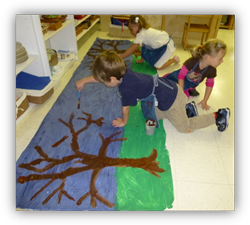
The all-day children had lots of fun painting our fall mural hanging in the hallway. The children used dark blue, brown, and green tempera to paint the fall landscape. It’s so fun to paint on a large surface on your hands and knees – using your whole body!
We have been very busy drawing, coloring, and poking out leaves, pumpkins, ghosts, apples, bats, owls, birds, raccoons, squirrels and more. It’s a fun work-in-progress. Each day there are new additions to our mural.
Story time is a daily activity in the afternoon. I read to the children and they also ready quietly to themselves. As of late, we have been drawing pictures inspired by these stories. The Lupine Lady, Ferdinand the Ball, Spiderman and Transformers are some of our favorites. The children draw something of their choosing from the story on a large piece of paper. They then write by themselves, or with my help, their version of the story. Lots of creativity, imagination and small motor control are used in these works of art!
Best regards,
Ms. Terri

